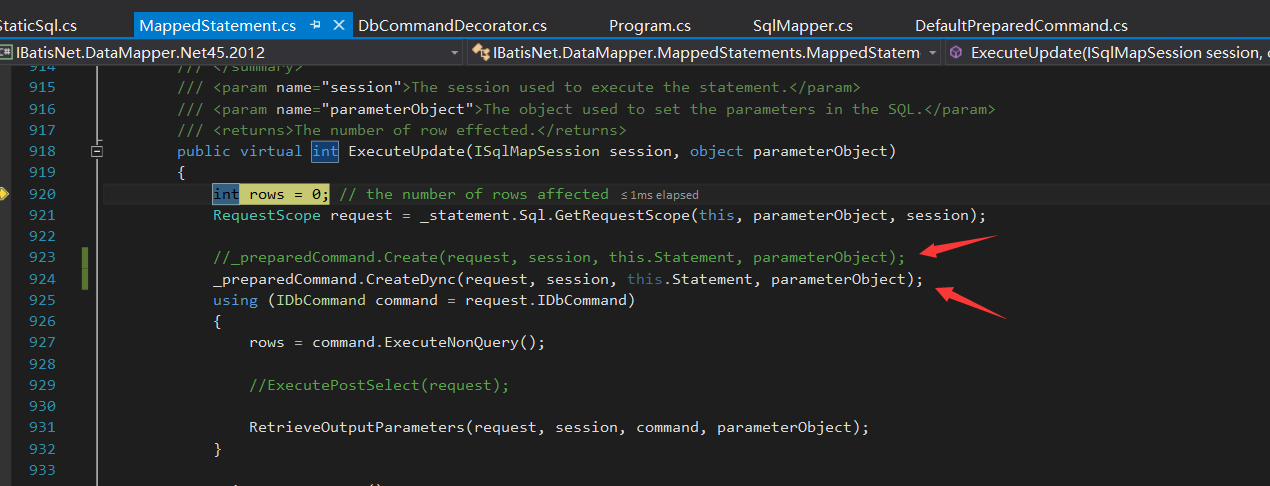动态Update语句
如果Map中指定多个字段
<update id="UpdateStaff">
update Staff set Name=#Name#,InDate=#InDate# where StaffId=#StaffId#
</update>
使用以下代码会有麻烦

第25行注释掉的话,你会发现InDate会被设置为null.而实际的工作我们并不希望一行数据所有字段都刷新一次,因为在大型系统里每次都这样做的话,风险太高。
如果只更新指定的字段的内容呢,已有人做出尝试,我觉得不错。
https://www.cnblogs.com/myitroad/p/5516963.html
但我觉得应调整原有的机制(改源代码),减少日常的开发工作。我准备使用“UpdateSetClip"代替Set部分
<update id="UpdateStaff">
update Staff set [UpdateSetClip] where StaffId=#StaffId#
</update>
好了,修改好sqlMap,不断的跑代码,不断的调整程序,直到满意:)
这是调整的位置,使用了一个新增的方法CreateDync,意思为动态创建

以下是主要代码,源代码文件:IBatisNet.DataMapper.Commands.DefaultPreparedCommand.cs
public void CreateDync(RequestScope request, ISqlMapSession session, IStatement statement, object parameterObject)
{
request.IDbCommand = new DbCommandDecorator(session.CreateCommand(statement.CommandType), request);
//request.PreparedStatement.()
if (_logger.IsDebugEnabled)
{
_logger.Debug("Statement Id: [" + statement.Id + "] PreparedStatement : [" + request.IDbCommand.CommandText + "]");
}
ApplyParameterMap(session, request.IDbCommand, request, statement, parameterObject);
//
string lastSql = applyParameterDyncSetClip(session, request.IDbCommand, request, statement, parameterObject);
request.IDbCommand.CommandText = lastSql;
}
/// <summary>
/// 应用动态字段set语句
/// </summary>
/// <param name="session"></param>
/// <param name="command"></param>
/// <param name="request"></param>
/// <param name="statement"></param>
/// <param name="parameterObject"></param>
private string applyParameterDyncSetClip(ISqlMapSession session, IDbCommand command,
RequestScope request, IStatement statement, object parameterObject)
{
Dictionary<string, object> dict = parameterObject as Dictionary<string, object>;//将参数转为字典
if (dict == null)
return request.PreparedStatement.PreparedSql;
string _updateStr = "";//动态Set部分,以空格开始
int index = request.PreparedStatement.DbParametersName.Count;
foreach (var one in dict)//build command set DataParameter
{
if (request.PreparedStatement.DbParametersName.Contains(one.Key))
continue;
index++;
IDbDataParameter parameterCopy = request.IDbCommand.CreateParameter();
parameterCopy.ParameterName = string.Format("{0}param{1}", session.DataSource.DbProvider.ParameterPrefix, index);
parameterCopy.Value = one.Value;
request.IDbCommand.Parameters.Add(parameterCopy);
_updateStr += string.Format("{0} = {1},", one.Key, parameterCopy.ParameterName);
}
_updateStr = _updateStr.TrimEnd(',');
return request.PreparedStatement.PreparedSql.Replace("[UpdateSetClip]", _updateStr);
}
细心的朋友会发现这个只支持字典,是的。字典(key/value)将是开源HIS中经常会见到。其实XML、Json都可以使用key/value来表示。所以自定义类似乎并不是必选项。当然实体类(属性对应表的字段)依然是推荐的技术手段。真正讨论开源HIS源码的时候再详谈。